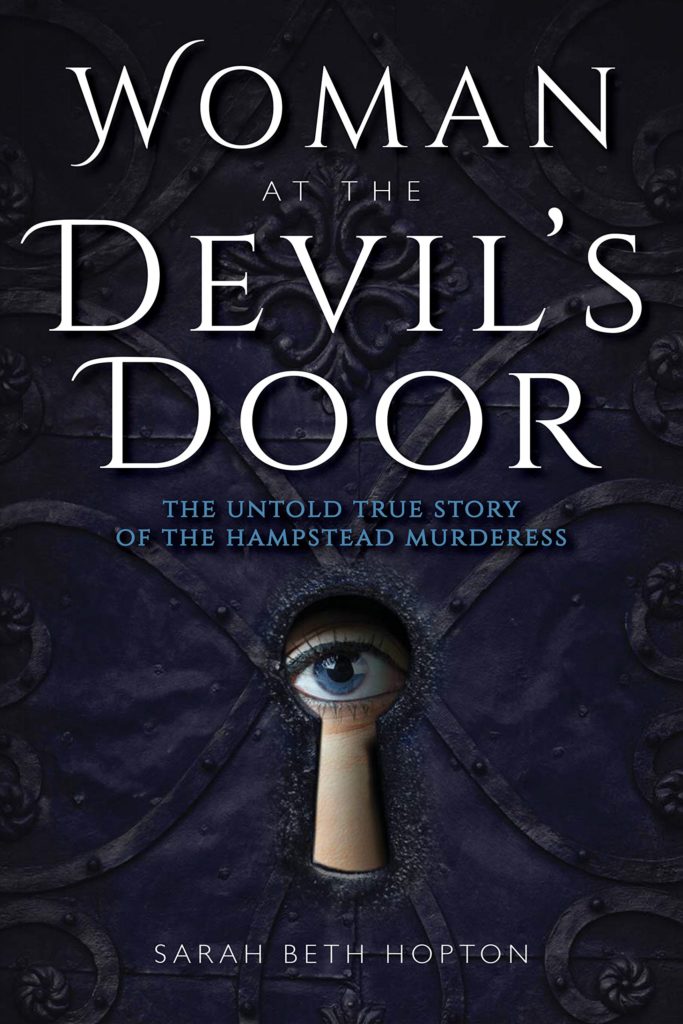Reviewed by Bryanna Mathews
According to the Radford Serial Killer Database, serial killers are ten times more likely to be male than female. There are few women whose lives and legacies are encapsulated by the many lives they ended. Along with Aileen Wuornos, Lizzie Borden, and Karla Homolka, Mary Eleanor Pearcey joins the ranks of infamous female serial killers.
 Told in six parts, Woman at the Devil’s Door: The Untold True Story of the Hampstead Murderess (Indiana University Press, June 2018) is a decade-long passion project undertaken by Sarah Beth Hopton. At the center of Hopton’s meticulously researched true crime debut is Mary Eleanor Pearcey, a young woman who led a mysterious life and eventually became one of the most notorious killers of England’s Victorian era.
Told in six parts, Woman at the Devil’s Door: The Untold True Story of the Hampstead Murderess (Indiana University Press, June 2018) is a decade-long passion project undertaken by Sarah Beth Hopton. At the center of Hopton’s meticulously researched true crime debut is Mary Eleanor Pearcey, a young woman who led a mysterious life and eventually became one of the most notorious killers of England’s Victorian era.
First, Hopton details the crime in question. In October 1890, the remains of an unidentified woman appeared in North London. Her face and hair were bloodied. Deep gashes marked her forearms, hands, and knuckles. Her head clung to her neck by mere threads of skin. By all appearances to the detectives that arrived on the scene, this woman was the subject of her killer’s rage. However, what wasn’t immediately clear to them was who their victim was. When her murder circulated throughout the local newspapers, her family eventually identified the woman as Phoebe Hogg, and the body of her missing toddler, Tiggie was found beneath a nettle bush.
Oftentimes, investigators look to those closest to the victims for clues, motive, and potential suspects. Phoebe’s husband, Frank Hogg, admitted to having an affair with Pearcey, who was a family friend. Once the detectives arrived to enter Pearcey’s home and caught sight of the blood spattered walls and rug and broken glass strewn about, the detectives believed they found a promising lead.
Pearcey’s subsequent arrest and murder trial immediately generated public interest, as if it were the OJ Simpson trial. Not only was this a crime of such brutality and horror that it drew comparisons to that of Jack the Ripper, but it was carried out by a woman.
In the portion of the book titled, “The Murderess, the Wife, and the Mistress,” Hopton attempts to piece together the lives of all of those involved. What forces were driving Frank to maintain this affair? Was Phoebe as happy in their marriage as Frank and his family would like to believe? What led to Phoebe’s final moments with Pearcey? Did Frank know what was to come?
For the murder trial, the narrative of a scorned woman killing her lover’s wife and child is an easy story to tell to a court, especially with circumstantial evidence and a potential murder weapon. If investigators know anything, often times eyewitnesses cannot relay the same story that forensics can. And despite the overwhelming amount of evidence against her, Pearcey maintained her innocence, even after being sentenced to death.
Following the sentencing, her lawyer pleaded with the court that Pearcey acted violently due to her epilepsy, and that the verdict should be reconsidered due to insanity. However, she was unable to secure a stay of execution. In the moments leading up to her execution, she appeared resigned to her fate. Her parting words: “M.E.C.P. – Last wish of M.E.W.; Have not betrayed,” were as opaque and mysterious as her life.
Woman at the Devil’s Door is a fantastic study of a long-forgotten crime. Sarah Beth Hopton’s keen interest in the particulars is what stands out most in this work. The seemingly miniscule details like the development of forensic sciences during the Victorian era, the public’s misunderstanding of epilepsy to the conditions of Pearcey’s holding cell are treated with grave importance. It offers insight into what influences were present in the judicial system, public perception, and societal expectations during the time that the murder took place. Hopton crafted a page-turning book that reads like a forensic thriller. Hopton’s appreciation for crime writing is evident and creates an experience for the reader that is as memorable as the murder she details.
 Bryanna Mathews is an airman in the United States Air Force. She is currently pursuing her passion in communications at University of Maryland University College. She lives in England with her husband and their dog, Finn the Human, that they have yet to adopt. When she is not on Instagram (follow her @nineinchnelle), she is reading or failing at baking cakes.
Bryanna Mathews is an airman in the United States Air Force. She is currently pursuing her passion in communications at University of Maryland University College. She lives in England with her husband and their dog, Finn the Human, that they have yet to adopt. When she is not on Instagram (follow her @nineinchnelle), she is reading or failing at baking cakes.


